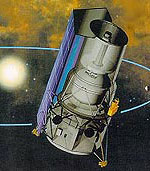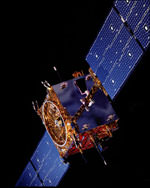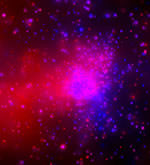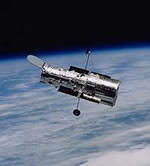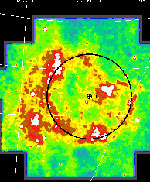
Image credit: NSF
Astronomers have used the accuracy of the National Science Foundation’s Very Long Baseline Array (VLBA) to pinpoint the distance to a pulsar. The object, called PSR B0656+14, was previously thought to be up to 2,500 light-years away but it was at the same location in the sky as a supernova remnant which is only 1,000 light years away. This was thought to be a coincidence, but the new measurement from the VLBA pegs the pulsar at 950 light years away; the same distance as the remnant – they were both created by the same supernova blast.
Location, location, and location. The old real-estate adage about what’s really important proved applicable to astrophysics as astronomers used the sharp radio “vision” of the National Science Foundation’s Very Long Baseline Array (VLBA) to pinpoint the distance to a pulsar. Their accurate distance measurement then resolved a dispute over the pulsar’s birthplace, allowed the astronomers to determine the size of its neutron star and possibly solve a mystery about cosmic rays.
“Getting an accurate distance to this pulsar gave us a real bonanza,” said Walter Brisken, of the National Radio Astronomy Observatory (NRAO) in Socorro, NM.
The pulsar, called PSR B0656+14, is in the constellation Gemini, and appears to be near the center of a circular supernova remnant that straddles Gemini and its neighboring constellation, Monoceros, and is thus called the Monogem Ring. Since pulsars are superdense, spinning neutron stars left over when a massive star explodes as a supernova, it was logical to assume that the Monogem Ring, the shell of debris from a supernova explosion, was the remnant of the blast that created the pulsar.
However, astronomers using indirect methods of determining the distance to the pulsar had concluded that it was nearly 2500 light-years from Earth. On the other hand, the supernova remnant was determined to be only about 1000 light-years from Earth. It seemed unlikely that the two were related, but instead appeared nearby in the sky purely by a chance juxtaposition.
Brisken and his colleagues used the VLBA to make precise measurements of the sky position of PSR B0656+14 from 2000 to 2002. They were able to detect the slight offset in the object’s apparent position when viewed from opposite sides of Earth’s orbit around the Sun. This effect, called parallax, provides a direct measurement of distance.
“Our measurements showed that the pulsar is about 950 light-years from Earth, essentially the same distance as the supernova remnant,” said Steve Thorsett, of the University of California, Santa Cruz. “That means that the two almost certainly were created by the same supernova blast,” he added.
With that problem solved. the astronomers then turned to studying the pulsar’s neutron star itself. Using a variety of data from different telescopes and armed with the new distance measurement, they determined that the neutron star is between 16 and 25 miles in diameter. In such a small size, it packs a mass roughly equal to that of the Sun.
The next result of learning the pulsar’s actual distance was to provide a possible answer to a longstanding question about cosmic rays. Cosmic rays are subatomic particles or atomic nuclei accelerated to nearly the speed of light. Shock waves in supernova remnants are thought to be responsible for accelerating many of these particles.
Scientists can measure the energy of cosmic rays, and had noted an excess of such rays in a specific energy range. Some researchers had suggested that the excess could come from a single supernova remnant about 1000 light-years away whose supernova explosion was about 100,000 years ago. The principal difficulty with this suggestion was that there was no accepted candidate for such a source.
“Our measurement now puts PSR B0656+14 and the Monogem Ring at exactly the right place and at exactly the right age to be the source of this excess of cosmic rays,” Brisken said.
With the ability of the VLBA, one of the telescopes of the NRAO, to make extremely precise position measurements, the astronomers expect to improve the accuracy of their distance determination even more.
“This pulsar is becoming a fascinating laboratory for studying astrophysics and nuclear physics,” Thorsett said.
In addition to Brisken and Thorsett, the team of astronomers includes Aaron Golden of the National University of Ireland, Robert Benjamin of the University of Wisconsin, and Miller Goss of NRAO. The scientists are reporting their results in papers appearing in the Astrophysical Journal Letters in August.
The VLBA is a continent-wide system of ten radio- telescope antennas, ranging from Hawaii in the west to the U.S. Virgin Islands in the east, providing the greatest resolving power, or ability to see fine detail, in astronomy. Dedicated in 1993, the VLBA is operated from the NRAO’s Array Operations Center in Socorro, New Mexico.
The National Radio Astronomy Observatory is a facility of the National Science Foundation, operated under cooperative agreement by Associated Universities, Inc.
Original Source: NRAO News Release
